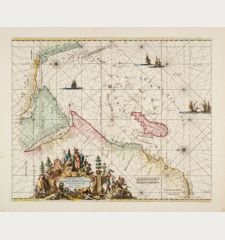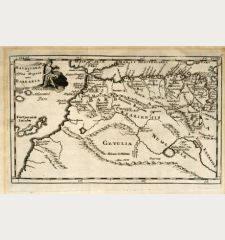Product successfully added to your shopping cart
There are 0 items in your cart. There is 1 item in your cart.
Parte de l'Africa
Giovanni Battista Ramusio (*1485 - †1557)Reference 12921
Description
Early woodcut map of Western Africa by G. B. Ramusio after Giacomo Gastaldi. First published in 1556, it is one of the earliest maps of Africa grounded substantially in contemporaneous information. Covering the western part of the continent and the Guinea Coast, the map stretches from present-day Mauritania to Cameroon. It featured in Ramusio's Delle Navigationi et Viaggi, the first compilation of first-hand travelers' reports. This example comes from the early second edition of 1565, with additional illustration of two sea monsters.
R. V. Tooley's notes on this map:
A charming pictorial woodcut map of West Africa from the Tropic of Cancer southward to the Guinea Coast.
Drawing on Portuguese explorer accounts and the writings of Leo Africanus, the map offers a detailed depiction of the western coastline, highlighting significant locations such as Castel de la Mina, the infamous Portuguese slave fort in present-day Ghana, along with Cape Verde, the Gambia River, Senegal, Sierra Leone, and the Mandinga River. The map features a ship bearing the Portuguese arms sailing to La Mina, while another ship with the French fleur-de-lis is depicted sailing to Sierra Leone and the Costa de la Melegeta.
Ramusio's map offers less insight into the interior of Africa, a region that remained opaque to European explorers until the late 19th century. Some place names do have a basis in actual reports; for instance, the Empire of Benin is named, reflecting Portuguese encounters with the kingdom and their trade in ivory, gold, and slaves.
Details
| Cartographer | Giovanni Battista Ramusio |
| Title | Parte de l'Africa |
| Publisher, Year | Tommaso Giuntis, Venice, 1556 [1565] |
| Plate Size | 27.0 x 37.0 cm (10.6 x 14.6 inches) |
| Sheet Size | 31.6 x 39.5 cm (12.4 x 15.6 inches) |
| Reference | Norwich, O.I.: Maps of Africa, No. 314; Karrow, R. W.: Mapmakers of the Sixteenth Century and their Maps, 30/82. |
Condition
Cartographer
Giovanni Battista Ramusio was an Italian geographer, humanist, scholar, historian, and travel writer active during the mid-16th century. Primarily serving the Republic of Venice, he initially participated in the state's embassy to France and later reported on voyages and discoveries. Born into a distinguished family in Treviso, Ramusio moved to Venice in his youth, where his father held a magisterial position. Although he studied at the University of Padua, it's uncertain whether he completed a full degree. Soon after leaving the university, he joined the civil service, leveraging his linguistic skills, particularly in French, to undertake diplomatic assignments.
Ramusio's most significant contribution to cartography is the publication of Navigation et Viaggi, a collection of travel narratives compiled during his service to the state. This compilation features accounts from various explorers, including Marco Polo, Niccolò Da Conti, Magellan, Alvar Núñez Cabeza de Vaca, Giosafat Barbaro, and Tomé Pires, among others. Some of the voyages presented in Navigation et Viaggi were previously unknown, highlighting its exceptional importance. In addition to the travelogues, it contained also a description of Africa, entitled Della descrittione dell'Africa. Ramusio passed away in Venice in 1557.
Images to Download
If you like to download the image of this map with a resolution of 1200 pixels, please follow the link below.
You can use this image for publication on your personal or commercial websites for free if you set a link to this website. If you need photographs with a higher resolution, please contact us.
West Africa - Ramusio, Giovanni Battista - Parte de l'Africa

![Giovanni Battista Ramusio: Parte de l'Africa Antique Maps, Ramusio, West Africa, 1556 [1565]: Parte de l'Africa](https://www.vintage-maps.com/4474-large_default/ramusio-west-africa-1556-1565.jpg)
![[Manuscript Chart of the South Atlantic Ocean] Tweede stuck wassende Graedkaert van de Kaap Verdische Eilanden tot de Kaap [Manuscript Chart of the South Atlantic Ocean] Tweede stuck wassende Graedkaert van de Kaap Verdische Eilanden tot de Kaap](https://www.vintage-maps.com/3745-home_default/blaeu-manuscript-1690.jpg)
![[Tab. Mo. Primae Partis Aphricae et Tabula Secunde partis Aphricae.] [Tab. Mo. Primae Partis Aphricae et Tabula Secunde partis Aphricae.]](https://www.vintage-maps.com/3651-home_default/fries-north-africa-1525.jpg)


